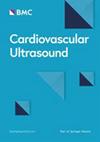Signal-to-noise of linear and volume measures of left ventricular and left atrial size
IF 1.6
3区 医学
Q3 CARDIAC & CARDIOVASCULAR SYSTEMS
引用次数: 0
Abstract
Serial echocardiographic assessments are common in clinical cardiology, e.g., for timing of intervention in mitral and aortic regurgitation. When following patients with serial echocardiograms, each new measurement is a combination of true change and confounding noise. The current investigation compares linear chamber dimensions with volume estimates of chamber size. The aim is to assess which measure is best for serial echocardiograms, when the ideal parameter will be sensitive to change in chamber size and have minimal spurious variation (noise). We present a method that disentangles true change from noise. Linear regression of chamber size against elapsed time gives a slope, being the ability of the method to detect change. Noise is the scatter of individual points away from the trendline, measured as the standard error of the slope. The higher the signal-to-noise ratio (SNR), the more reliably a parameter will distinguish true change from noise. LV and LA parasternal dimensions and apical biplane volumes were obtained from serial clinical echocardiogram reports. Change over time was assessed as the slope of the linear regression line, and noise was assessed as the standard error of the regression slope. Signal-to-noise ratio is the slope divided by its standard error. The median number of LV studies was 5 (4–11) for LV over a mean duration of 5.9 ± 3.0 years in 561 patients (diastole) and 386 (systole). The median number of LA studies was 5 (4–11) over a mean duration of 5.3 ± 2.0 years in 137 patients. Linear estimates of LV size had better signal-to-noise than volume estimates (p < 0.001 for diastolic and p = 0.035 for systolic). For the left atrium, the difference was not significant (p = 0.214). This may be due to sample size; the effect size was similar to that for LV systolic size. All three parameters had a numerical value of signal-to-noise that favoured linear dimensions over volumes. Linear measures of LV size have better signal-to-noise than volume measures. There was no difference in signal-to-noise between linear and volume measures of LA size, although this may be a Type II error. The use of regression lines may be better than relying on single measurements. Linear dimensions may clarify whether changes in volumes are real or spurious.左心室和左心房大小的线性和容积测量信噪比
连续超声心动图评估在临床心脏病学中很常见,例如用于确定二尖瓣和主动脉瓣反流的介入时机。在对患者进行连续超声心动图随访时,每次新的测量都是真实变化和干扰噪声的结合。目前的研究比较了线性心腔尺寸和心腔容积估计值。目的是评估哪种测量方法最适合连续超声心动图检查,因为理想的参数应该对心腔大小的变化敏感,并具有最小的假性变化(噪声)。我们提出了一种将真实变化与噪声区分开来的方法。心腔大小与所用时间的线性回归得出一个斜率,即该方法检测变化的能力。噪声是各点偏离趋势线的散度,以斜率的标准误差来衡量。信噪比(SNR)越高,参数就越能可靠地区分真实变化和噪声。左心室和左心室胸骨旁尺寸以及心尖双平面容积均来自连续的临床超声心动图报告。随时间的变化以线性回归线的斜率进行评估,噪声以回归斜率的标准误差进行评估。信噪比为斜率除以标准误差。在561名患者(舒张期)和386名患者(收缩期)的5.9±3.0年平均病程中,左心室研究的中位数为5(4-11)次。LA研究的中位数为5(4-11)次,137例患者的平均病程为5.3±2.0年。左心室大小的线性估计信噪比优于容积估计信噪比(舒张期p < 0.001,收缩期p = 0.035)。左心房的差异不显著(p = 0.214)。这可能与样本量有关;其效应大小与左心室收缩大小的效应大小相似。所有三个参数的信噪比数值都是线性尺寸优于容积。左心室大小的线性测量值比容积测量值具有更好的信噪比。线性和容积测量 LA 尺寸的信噪比没有差异,尽管这可能是 II 类错误。使用回归线可能比依赖单一测量更好。线性尺寸可以明确容积的变化是真实的还是虚假的。
本文章由计算机程序翻译,如有差异,请以英文原文为准。
求助全文
约1分钟内获得全文
求助全文
来源期刊

Cardiovascular Ultrasound
CARDIAC & CARDIOVASCULAR SYSTEMS-
CiteScore
4.10
自引率
0.00%
发文量
28
审稿时长
>12 weeks
期刊介绍:
Cardiovascular Ultrasound is an online journal, publishing peer-reviewed: original research; authoritative reviews; case reports on challenging and/or unusual diagnostic aspects; and expert opinions on new techniques and technologies. We are particularly interested in articles that include relevant images or video files, which provide an additional dimension to published articles and enhance understanding.
As an open access journal, Cardiovascular Ultrasound ensures high visibility for authors in addition to providing an up-to-date and freely available resource for the community. The journal welcomes discussion, and provides a forum for publishing opinion and debate ranging from biology to engineering to clinical echocardiography, with both speed and versatility.
 求助内容:
求助内容: 应助结果提醒方式:
应助结果提醒方式:


